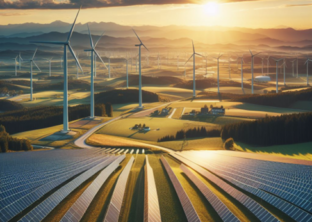Carbon Capture – Approaches in the Concrete Industry
Carbon capture is an important part of the European strategy for a climate-neutral economy by 2050. The EU has taken several initiatives and measures to promote the development and application of carbon capture, showing the importance of CO2 capture as a key building block for a climate-neutral future.
Looking at the emitters of CO2, industry is the sector with the largest global emissions with a share of 31 percent, including the cement and steel industries with a share of 19 percent each in relation to the industrial share.

Cement production is currently responsible for a total of about 5 percent of global CO2 emissions (19 percent in relation to the industry segment) and it is clear that conventional carbon capture technologies are not sufficient to mitigate the industry’s climate impact. Especially since the demand for concrete will continue to increase in the future. Therefore, alternative technologies such as geopolymer-based cements or carbon-enriched concrete are being researched on a building materials basis.
- Substitution of cement: In geopolymer concrete, the traditional cement is replaced as a binder by minerals, alkalis, and an activator (geopolymer). According to research, the lime-free alternative to normal concrete is particularly low in CO2 in the production process – by up to 70 percent.
- Binding of carbon: In carbon enriched concrete, CO2 is bound in the granulate during the production process. In initial test plants, up to 10 kilogrammes of CO2 per cubic metre could be permanently bound in recycled concrete in crystalline form.
Another promising technology is direct air capture (DAC). This is a process that separates CO2 directly from the air. DAC can therefore be used to mitigate CO2 emissions from a variety of sources, including those that are mobile and dispersed or difficult to decarbonise.
The technology also has a wide range of applications in decarbonising cement production. This includes the introduction of industry accepted alternatives such as ‘carbon cured’ cements. These cements can absorb CO2 captured by DAC instead of water as they harden, while strengthening the final concrete product. If this CO2 absorption occurs faster than CO2 release during manufacture, cement can become a carbon sink or technically carbon negative. DAC still faces high costs, high energy requirements and regulatory uncertainties. Increased research and development accelerated demonstration and scaling-up, and the creation of markets for captured CO2 or low-carbon products are needed to make DAC competitive.

The need to reduce carbon emissions is recognised by the industry and there is a variety of initiatives aimed at reducing CO2 emissions.
In addition, efforts are also being made to improve the energy efficiency of cement production, for example by using renewable energies such as wind and solar power. Furthermore, regulation and taxation of carbon emissions could create incentives for the industry to implement emission-reducing technologies.

Yvonne Jacoby, Market Intelligence Senior Expert
Sources:
- https://www.baublatt.ch/baupraxis/co2-speicherung-im-beton-richtig-gas-geben-bei-der-dekarbonatisierung-30871;
- https://www.recyclingmagazin.de/2023/01/11/co2-kreislauf-bei-beton-schliessen/;
- https://www.uni-due.de/materials/forschung_beton.php;
- https://www.aramco.com/en/sustainability/climate-change/managing-our-footprint/carbon-curing;
- https://rhg.com/research/global-greenhouse-gas-emissions-2021/ ;
- https://www.globalefficiencyintel.com/new-blog/2021/global-cement-industry-ghg-emissions.







